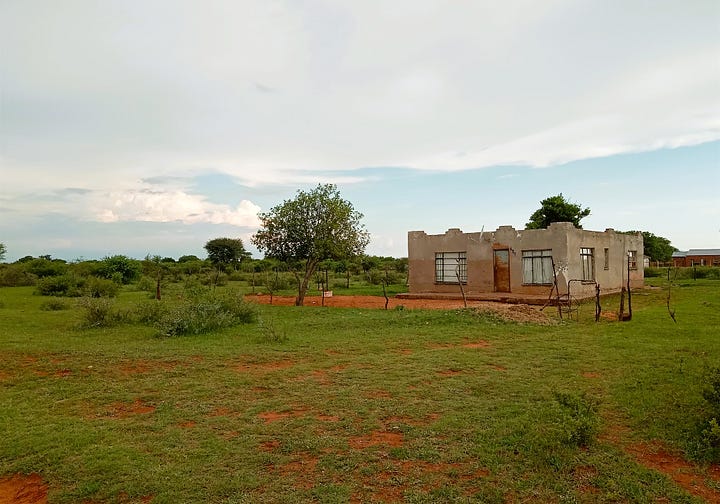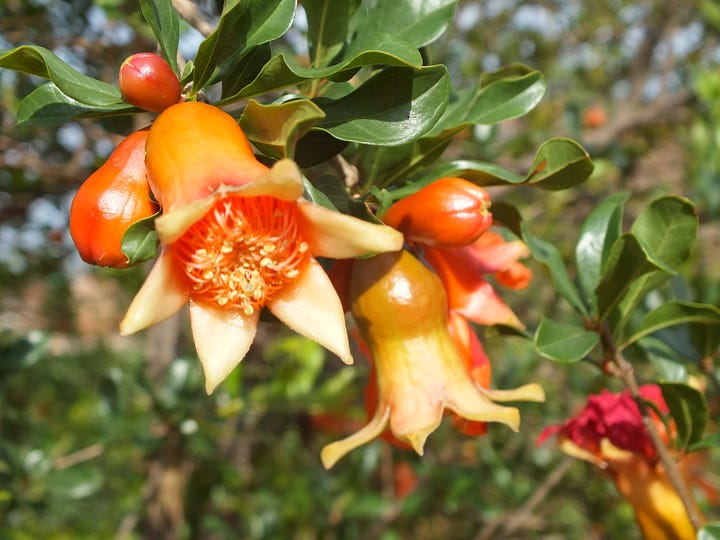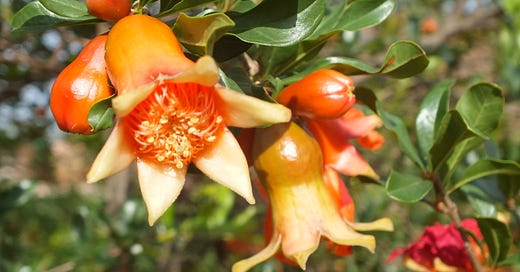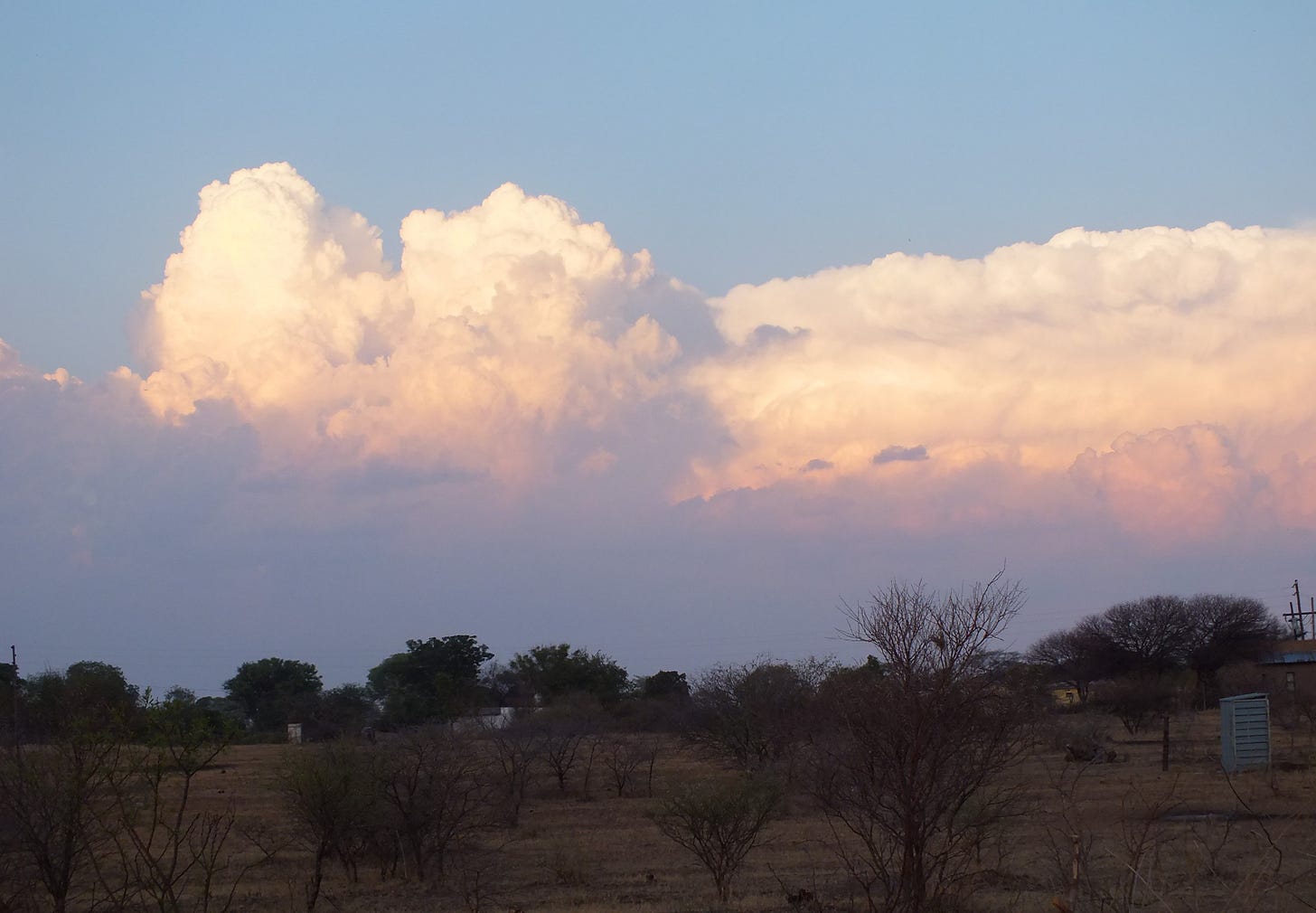Unlike my previous posts, I had trouble just settling on a title (for me usually the easiest part of narrative writing) for this one: is this even spring or summer anyway? Certainly this span of recent weeks has revealed characteristics of both — wind, rain and dust storms, vegetative renewal, blazing sun and searing heat. But regardless of what we call it, this being a season of gratitude, I certainly did not want to take these changes for granted. So here goes: I am grateful for the rains that returned a few weeks ago — after a six-month hiatus — which have triggered a proliferation of verdure and blooms both on the veld and around local gardens and homes. I’m pleased to note the flush of soft green and crimson shoots at the base of our winter-killed mango and guava trees; it’s heartening to think that in just about a year big juicy mangoes will once again be ready for picking (sooner for the guavas).





I’m thankful for the water that has started streaming from roof gutters to refill the large plastic drums upon which we are so dependent for cooking and drinking (because the local groundwater is heavy in salts, it is generally not used for drinking even by families that have their own wells). For now at least — unlike during the dry winter — there is no need to arrange water deliveries: the large ones coming via trucks or tractor-drawn wagons and the smaller ones in jugs atop donkey carts or wheelbarrows. I’m grateful for the reemergence of clouds, which — in addition to casting a little shade and adding visual interest to the skies — have induced frequent afternoon breezes providing a nice respite from this increasing heat.




It’s nice to see the fields being plowed once again in advance of planting maize, sorghum, beans and chard. Unlike the smaller scale winter gardens, these grander cultivation schemes rely mostly on natural rainfall. Thus, timing is critical: plant too early and the young crops could wither before their roots have had a chance to become fully established; too late and, as happened last year, the crop could be nailed ahead of its time by an early return of the dry season.
I happily celebrate the conspicuous return of wildlife to area — from the humble millipedes traipsing across the ground after a rain; to the butterflies visiting the blooms; to the blue-headed agama lizards chasing about the tree trunks; to the spurfowl scurrying through the brush; to the sand frogs, even the one that went for a recent wallow in the cat’s water bowl (she didn’t seem so amused). As for the menacing crepuscular visitors — notably the ravenous mosquitoes and the bombarding chafer beetles (apparently drawn indoors from their breeding frenzies by the lights which I gladly switch on upon completion of the evening’s regular power interruption) — I won’t laud their return other than to say that they’re all part of the fabric of the place. And I won’t speak to the increasingly stifling heat and humidity (it’s projected to get downright ugly this week) that are prime movers of many of these critters, other than to express my gratitude for those most unsung but vital of bedroom fixtures: the mosquito net and pedestal fan.


And finally, of course, there are the ‘dinonyane’ — the impressive parade of migrating and nesting songbirds that we have been witnessing lately. It’s entertaining to watch the weavers — southern-masked and the white-browed sparrow weaver — industriously weaving their hanging abodes (the differences in their shapes and the placement of their entry holes distinguishing the species). Their antics even attract the interest of some of our school’s learners, who during their final days of the term have enjoyed coming out to spot them through binoculars or bare eyes. Some, as young as Grade 2, are becoming adept at finding and identifying the common birds — masked weavers, common mynas, laughing doves, pied crows, even crested barbets — using a worn English-language pocket guide. They have yet to learn the pleasing songs of the local breeders: the repetitive chant of the Diederik cuckoo, the jingle of grey-headed sparrow and the sharp warble of the marico sunbird. Perhaps that will be in the cards for next year.







Thanks, Drew! Great to hear from you :) And awesome photos!!
As you know, we are heading into winter. Prospect Mountain opened recently and I hope to get out there soon. I'll ski a little extra for you!
Love, Laura
Some high quality photos you got - looks gorgeous there.